Understanding Breakup Cards: A Modern Way to Say Goodbye
In the ever-evolving landscape of relationships, the concept of breakup cards has emerged as a unique and modern way to address the delicate matter of ending a relationship. These cards, often imbued with a mix of humor, sincerity, and a touch of sadness, represent a new era in how people choose to say goodbye.
The idea of a breakup card might seem unconventional at first, but it's gaining traction in today's digital age, where personal expressions are often conveyed through various forms of media. Let's delve into the world of breakup cards and understand their place in modern relationships.
Breakup cards offer a way to express emotions that might be difficult to articulate face-to-face. They can range from light-hearted and humorous to deeply heartfelt and sincere, depending on the nature of the relationship and the message the sender wishes to convey.
While these cards can provide closure and a sense of respect towards the relationship, they also raise questions about the appropriateness and impact of such a method in handling breakups. Are breakup cards a thoughtful way to end things, or do they trivialize the emotions involved in a breakup? This article explores these nuances and more.
Key Takeaways:
- Breakup cards are a new trend in ending relationships, offering a unique way to express farewell.
- They can range from humorous to heartfelt, providing a means to articulate complex emotions.
- The appropriateness of breakup cards is debatable, raising questions about their impact on the emotional well-being of both parties.
The Emotional Impact of Breakup Cards: Pros and Cons
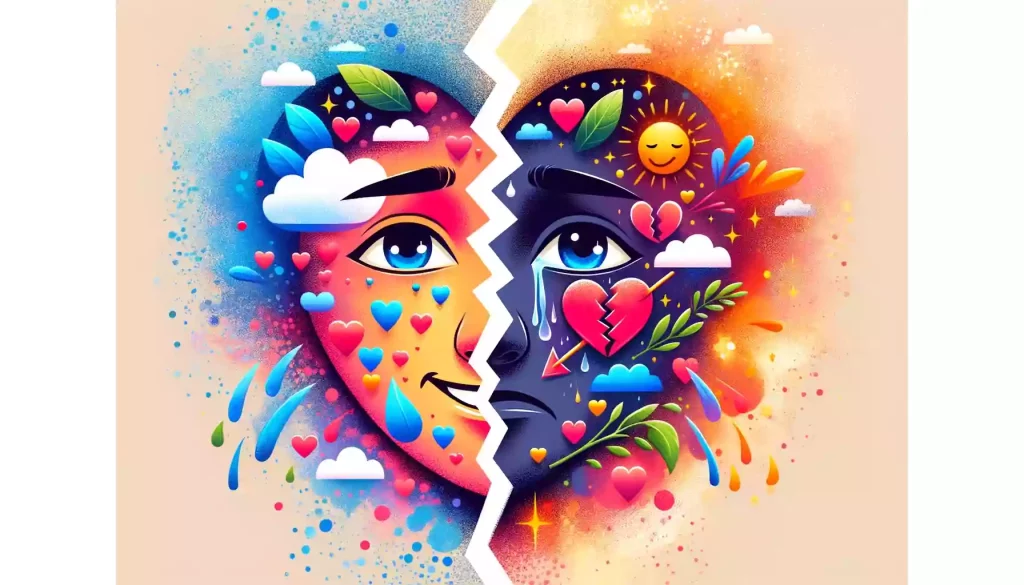
Breaking up is never easy, and the way it's done can significantly affect both parties involved. Breakup cards, as a medium for conveying the end of a relationship, carry a unique set of emotional implications. On one hand, they can provide a respectful and thoughtful way to communicate difficult feelings. On the other hand, they might be perceived as impersonal or insufficient for the gravity of the situation.
The pros of using a breakup card include the ability to carefully compose your thoughts and feelings, reducing the risk of saying something in the heat of the moment that you might regret. It allows for a clear and concise expression of your reasons for the breakup, potentially providing closure to the recipient.
However, the cons are equally notable. A breakup card can seem too detached or casual for such a significant emotional event. It might leave the recipient feeling slighted or that their relationship was not worth a face-to-face conversation. Additionally, it can hinder the opportunity for a real-time dialogue about the breakup, which some people find essential for closure.
The emotional impact of a breakup card can vary greatly depending on how it's written and the nature of the relationship. For some, it can feel like a considerate and mature approach, while for others, it might come across as cold and uncaring.
Ultimately, the decision to use a breakup card should be weighed carefully, considering both the message it conveys and the emotional well-being of both parties involved.
Designing the Perfect Breakup Card: Tips and Tricks
Creating a breakup card requires a delicate balance of honesty, sensitivity, and respect. The design and content of the card should reflect the seriousness of the message while also conveying your genuine feelings.
Tip 1: Choose a design that is simple and understated. Overly elaborate or humorous designs might undermine the seriousness of your message. A minimalist approach can convey your message with dignity and respect.
Tip 2: Be clear and honest in your wording. Avoid clichés and be sincere in expressing your reasons for the breakup. This is not the time for vague statements – clarity is key.
Tip 3: Acknowledge the good times. It's often helpful to mention positive aspects of the relationship. This can help soften the blow and show that you value the time spent together.
Tip 4: Maintain a respectful tone. Even if the breakup is due to negative reasons, it's important to communicate in a way that is respectful and considerate of the other person's feelings.
Tip 5: Consider adding a personal touch, like a handwritten note. This can make the card feel more personal and heartfelt, as opposed to a generic message.
What to Write in a Breakup Card: Dos and Don'ts
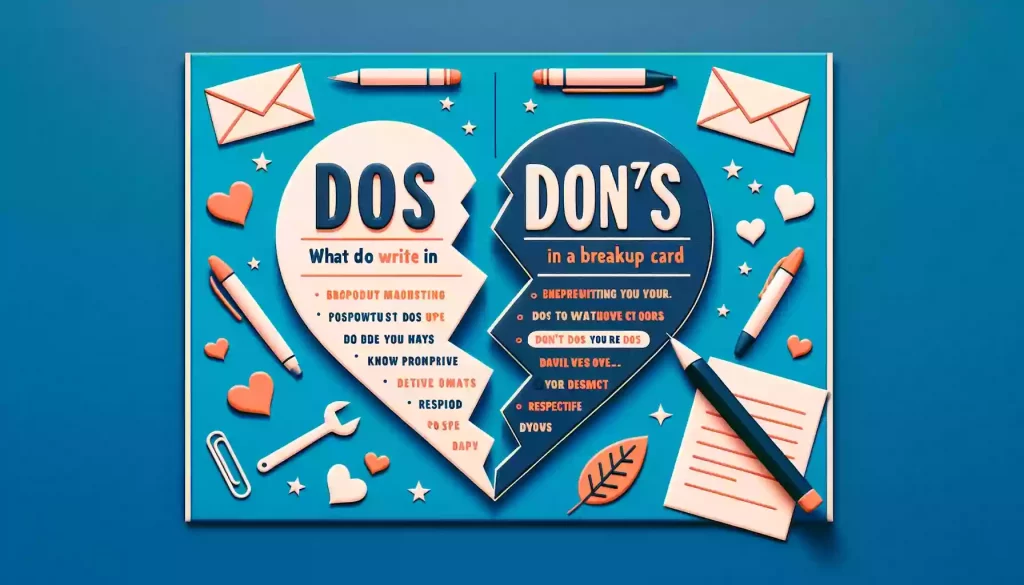
The content of a breakup card is crucial. It's the heart and soul of your message, and getting it right can make a significant difference in how your message is received. Here are some dos and don'ts to consider when composing your breakup card.
Do: Be honest but gentle. Your words should reflect the true reasons for the breakup, but they should be conveyed in a way that is not harsh or cruel. Avoid blaming language and focus on expressing your own feelings.
Don't: Use clichés or impersonal phrases. Phrases like "It's not you, it's me," can feel insincere and dismissive. Your card should reflect a genuine understanding of the relationship and its end.
Do: Acknowledge the positive aspects of the relationship. It's important to recognize the good times you shared and the lessons learned. This can offer a sense of closure and mutual respect.
Don't: Leave things ambiguous. A breakup card should provide clarity and closure, not leave the other person with unanswered questions or false hope.
Breakup Cards for Different Relationships: Friends, Lovers, Colleagues
The nature of your relationship greatly influences the tone and content of a breakup card. A card meant for a romantic partner differs significantly from one intended for a friend or colleague. Each type of relationship demands a specific approach to ensure the message is appropriate and respectful.
For friends, a breakup card might be used to address a drifting apart or a fallout. The tone can be more casual, focusing on the appreciation of the friendship and the importance of maintaining respect for each other's paths.
In the case of lovers, the card should be more intimate and heartfelt. It's essential to acknowledge the depth of the relationship and the pain of parting, while also expressing your reasons for the breakup with clarity and compassion.
For colleagues, if you're ending a professional relationship, the tone should be formal and respectful. The focus should be on the professional aspects of the relationship and the rationale for the decision, ensuring to maintain a positive tone for future interactions.
The Rise of Digital Breakup Cards: A New Trend
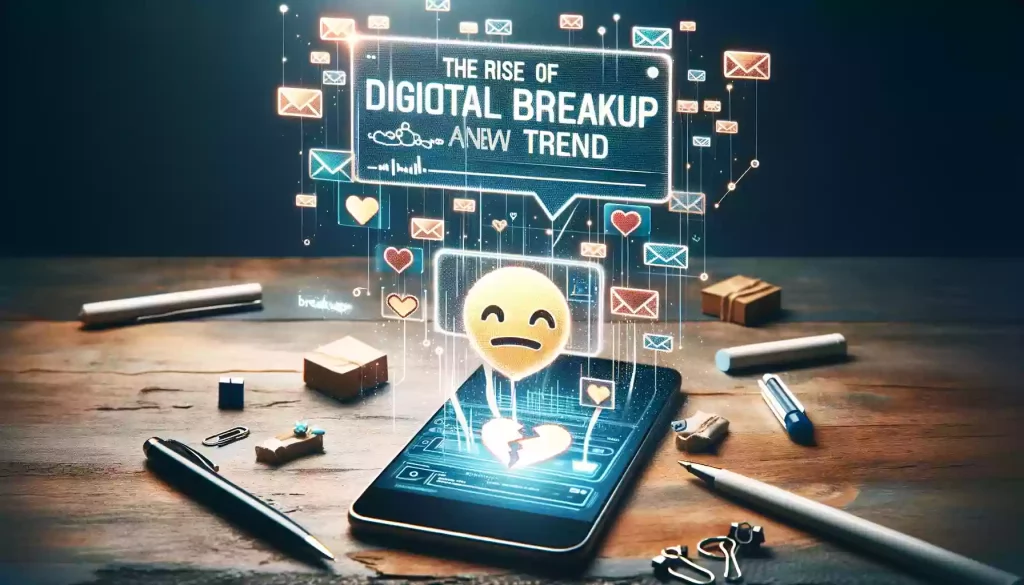
As digital communication continues to reshape our interactions, it's no surprise that even the realm of breakups has been influenced. Digital breakup cards are becoming an increasingly popular way to communicate the end of a relationship in the digital age. These cards, sent via email, social media, or messaging apps, offer a modern twist to the traditional breakup letter or card.
The appeal of digital breakup cards lies in their convenience and the ability to carefully craft your message without the immediate pressure of a face-to-face interaction. They allow for creative expression through multimedia elements like images, videos, or even interactive components, making the message more personal and engaging.
However, this trend also raises questions about the impersonality of digital communication. Does sending a breakup message through digital means diminish the significance of the relationship or the gravity of the breakup? This is a critical consideration in the age where digital interactions are often critiqued for lacking depth and sincerity.
Despite these concerns, the rise of digital breakup cards reflects a broader cultural shift towards embracing digital platforms for personal communication. For many, especially younger generations, digital cards can feel more natural and in line with their regular communication habits.
As with any form of breakup communication, the key lies in the thoughtfulness and sincerity of the message, regardless of the medium used to convey it.
How to Handle Receiving a Breakup Card
Receiving a breakup card can be an emotionally challenging experience. It's a tangible symbol of the end of a relationship, and navigating the feelings that come with it requires care and understanding. Here are some steps to consider when dealing with the receipt of a breakup card.
Step 1: Allow yourself to process the emotions. It's natural to feel a range of emotions, from sadness and anger to relief or confusion. Give yourself time and space to understand and work through these feelings.
Step 2: Reflect on the message. Try to understand the reasons behind the breakup as expressed in the card. This can be an important step in finding closure and moving forward.
Step 3: Avoid impulsive reactions. It can be tempting to respond immediately, especially if you're feeling hurt or angry. However, taking time to think about your response, or deciding not to respond at all, can be beneficial.
Step 4: Seek support from friends or family. Talking about your feelings with someone you trust can help you process the breakup and provide a different perspective on the situation.
Step 5: Focus on self-care and moving forward. Engaging in activities that you enjoy and that make you feel good can be an effective way to handle the emotional impact of the breakup.
Breakup Cards and Mental Health: Navigating the Emotions
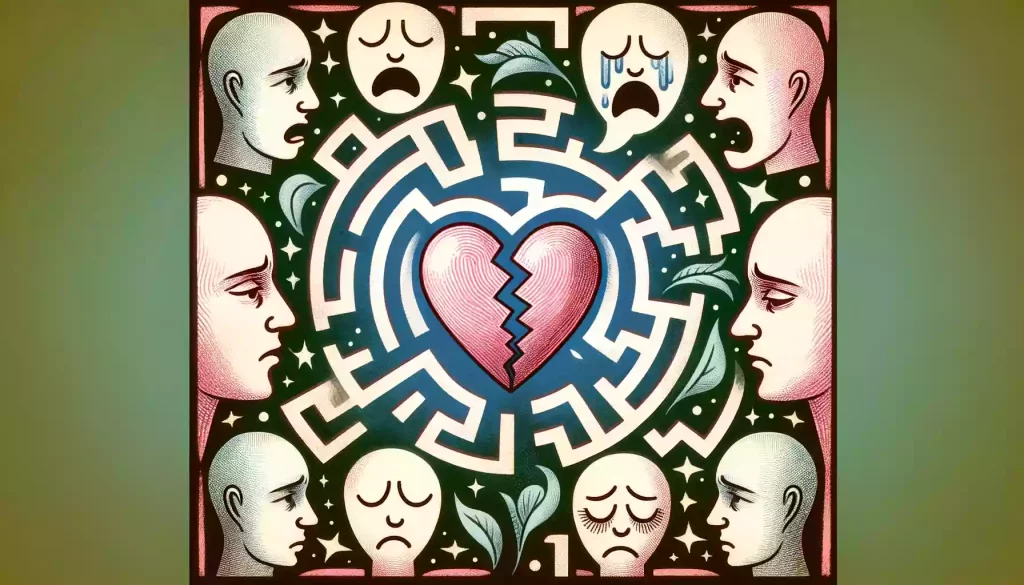
The use of breakup cards can have a profound impact on mental health, both for the sender and the recipient. Navigating the emotions that arise from sending or receiving a breakup card requires a nuanced understanding of one's emotional well-being.
For the sender, creating a breakup card can be a cathartic process, allowing them to articulate their feelings and reasons for the breakup. However, it can also lead to feelings of guilt or anxiety, especially if the sender is concerned about how their message will be received.
For the recipient, a breakup card can trigger a range of emotions, from shock and sadness to anger or relief. It's important to recognize that these emotions are a normal part of the grieving process that follows the end of a relationship.
Maintaining mental health during this time involves acknowledging these emotions, seeking support if needed, and engaging in self-care practices. It's also crucial to remember that healing is a journey, and it's okay to seek professional help if you're struggling to cope.
FAQs: Common Questions About Breakup Cards
Q1: Are breakup cards an appropriate way to end a relationship?
A1: The appropriateness of a breakup card depends on the nature of the relationship and the circumstances of the breakup. It can be a respectful way to articulate your feelings if done thoughtfully.
Q2: What should I include in a breakup card?
A2: Be honest and clear about your reasons for the breakup, acknowledge the positive aspects of the relationship, and maintain a respectful tone throughout.
Q3: Can a breakup card help with closure?
A3: A well-composed breakup card can provide closure by clearly stating the reasons for the breakup and expressing a final farewell.
Q4: Is it better to send a digital or physical breakup card?
A4: This depends on your and your partner's communication preferences. Digital cards offer convenience and immediacy, while physical cards may feel more personal and tangible.
Q5: How should I react to receiving a breakup card?
A5: Allow yourself to process your emotions, reflect on the message, and focus on self-care. Avoid impulsive responses and seek support if needed.
Q6: Can sending a breakup card affect my mental health?
A6: Yes, sending a breakup card can stir up a range of emotions and may impact your mental health. It's important to be mindful of your feelings and seek support if you feel overwhelmed.
Q7: Are there alternatives to sending a breakup card?
A7: Yes, alternatives include having a face-to-face conversation, a phone call, or writing a more detailed breakup letter, depending on what feels most appropriate for your situation.
Alternatives to Breakup Cards: Other Ways to Express Your Feelings
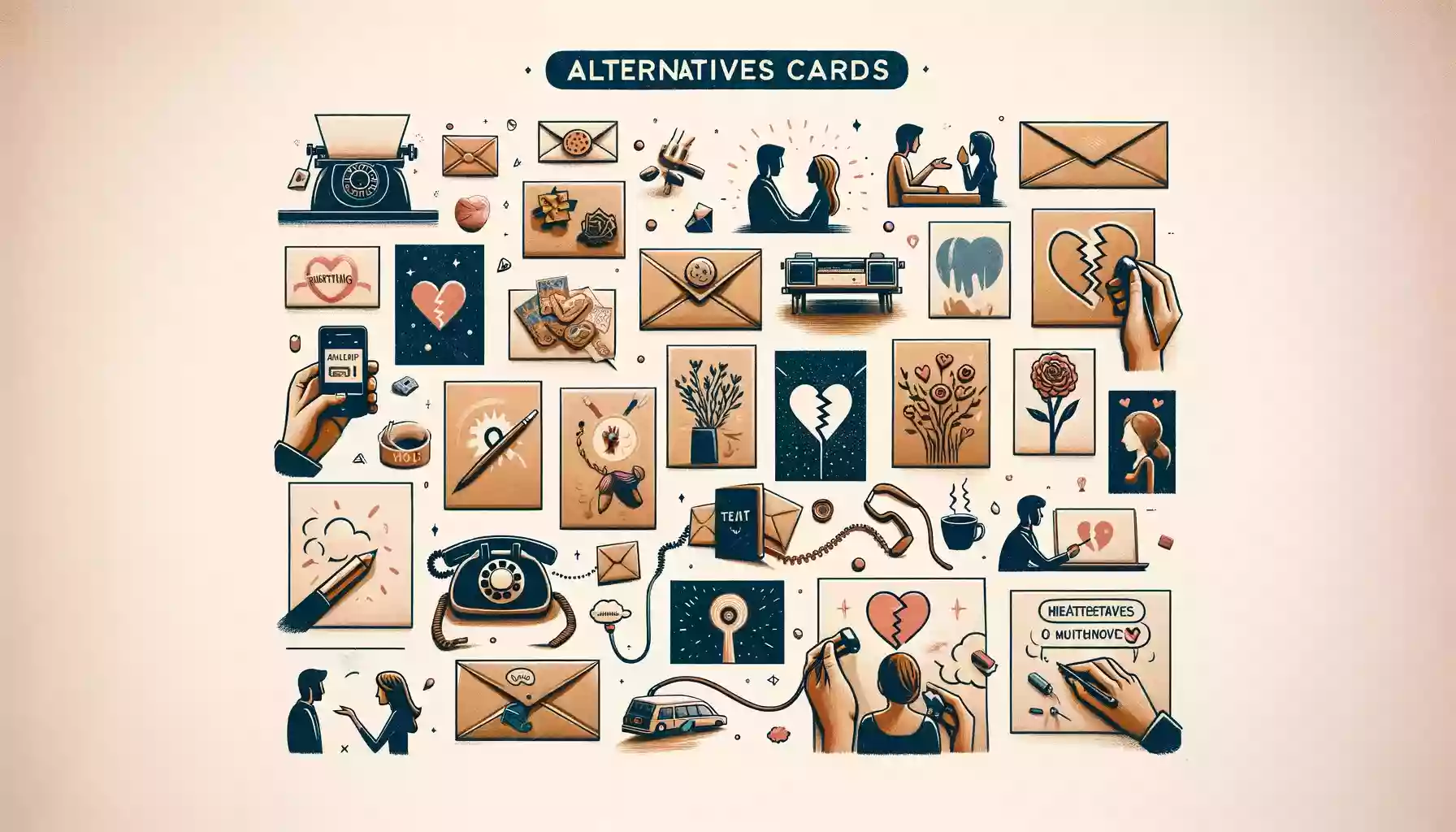
While breakup cards are one way to communicate the end of a relationship, there are several other methods that might be more suitable depending on the situation and the people involved. Each alternative offers a different way of expressing emotions and can be chosen based on personal preference and the nature of the relationship.
Face-to-Face Conversation: A direct, in-person conversation allows for immediate and genuine interaction. It can be more difficult, but it often provides the clarity and closure that digital or written communication cannot.
Phone Call: If an in-person conversation isn't feasible, a phone call can be a more personal alternative to a breakup card. It allows for real-time communication and the expression of tone, which can be important in conveying sincerity.
Handwritten Letter: For those who prefer written communication, a handwritten letter can be more personal and thoughtful than a breakup card. It provides space to express your thoughts and feelings in depth.
Email: Email allows for written communication that can be composed and sent at a convenient time. It's less personal than a letter but can be a good option for more formal or distant relationships.
Artistic Expressions: Some people find that expressing their feelings through art, music, or poetry is more fitting. This can be a therapeutic way to convey your emotions and a unique approach to a difficult conversation.
Cultural Perspectives on Breakup Cards
The use and perception of breakup cards can vary significantly across different cultures. Understanding these cultural nuances is important, as it affects how breakup cards are viewed and used globally.
In some cultures, direct communication such as face-to-face conversations is valued above all, making the idea of a breakup card seem impersonal or disrespectful. In these contexts, breakup cards may be frowned upon or misunderstood.
Conversely, in societies where indirect communication is more common, breakup cards can be seen as a thoughtful and respectful way to address a difficult situation, especially when confronting emotions directly is challenging.
The rise of digital communication has also impacted cultural perceptions. In cultures that rapidly adopt new technologies, digital breakup cards may be more accepted as a normal part of relationship dynamics.
Additionally, the level of formality and the importance of written communication in different cultures play a role. In cultures with a high regard for formal communication, a well-crafted breakup card might be seen as more appropriate than in cultures that prioritize informal, verbal communication.
The role of gender norms and expectations in various cultures also influences the acceptance and use of breakup cards. In some cultures, certain genders might be more likely to use or accept breakup cards, while in others, it might be considered unconventional.
Finally, the influence of globalization and exposure to different relationship norms through media and travel is gradually altering the cultural landscape, making practices like breakup cards more universal, yet still subject to regional variations.
The Future of Breakup Cards: Predictions and Trends
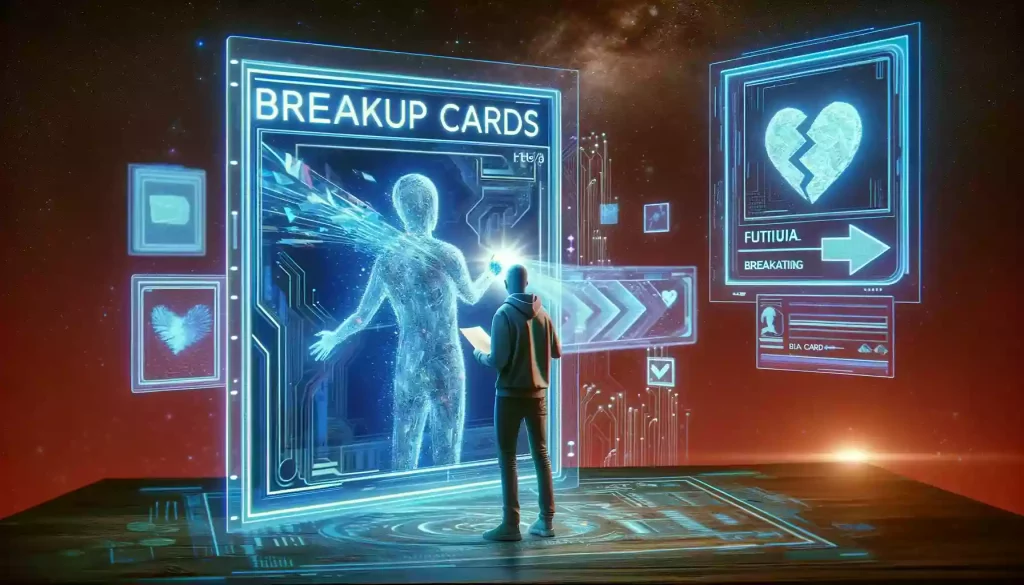
The landscape of breakup cards is likely to evolve with advancements in technology and changes in societal norms. As we look towards the future, several trends and predictions stand out, indicating how breakup cards may transform in the coming years.
One significant trend is the increasing integration of technology. We can expect to see digital breakup cards becoming more sophisticated, potentially incorporating elements like virtual reality or AI to create more immersive and personalized experiences. This could offer new ways to convey emotions and messages in a breakup.
Another prediction is the rise in the popularity of eco-friendly and sustainable options for breakup cards. As environmental awareness grows, there may be a shift towards digital cards or cards made from recycled materials, aligning with a more eco-conscious approach.
Furthermore, the concept of breakup cards could expand to include more interactive and collaborative elements, such as options for mutual closure or platforms for joint reflection on the relationship. This could help address some of the criticisms of breakup cards as being one-sided.
Key Takeaways from the World of Breakup Cards
As we wrap up our exploration of breakup cards, several key points stand out:
1. Versatility and Personalization: Breakup cards offer a range of options for personalization, allowing individuals to express their feelings in a way that suits their relationship and situation.
2. Emotional Impact: The use of breakup cards can have a significant emotional impact, both positive and negative, on both the sender and the recipient.
3. Cultural Variations: Cultural norms play a crucial role in how breakup cards are perceived and used, with different cultures having varying views on their appropriateness and impact.
4. Digital Evolution: The rise of digital breakup cards reflects broader changes in communication, offering new and innovative ways to convey breakup messages.
5. Future Trends: Looking ahead, the world of breakup cards is likely to see technological advancements and a shift towards more interactive and sustainable options.
Recommended Resources
- Why We Love: The Nature and Chemistry of Romantic Love, Helen Fisher, Henry Holt and Co., 2004
- Tiny Beautiful Things: Advice on Love and Life from Dear Sugar, Cheryl Strayed, Vintage, 2012
- The Wisdom of a Broken Heart: An Uncommon Guide to Healing, Insight, and Love, Susan Piver, Simon & Schuster, 2010







Recommended Comments
There are no comments to display.
Create an account or sign in to comment
You need to be a member in order to leave a comment
Create an account
Sign up for a new account in our community. It's easy!
Register a new accountSign in
Already have an account? Sign in here.
Sign In Now